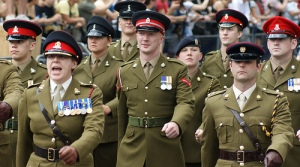From this side of the Atlantic, the continued reluctance to do away with DADT seems odd, at best... In the UK, gay men and lesbians not only serve freely and openly in the armed services and in the police, but can be seen every year participating in London Pride, marching in uniform through the streets of London - and in other gay pride marches up and down the country. Elsewhere in Europe, LGBT participation in the military is at least as relaxed.
It’s not even as if gay soldiers were a new idea. To demonstrate, I want to pay a brief visit to ancient history – but first, I have to ask, “Why do we have a military?” Obviously, for defence – but what is it exactly, we wish to defend? For many of us, that answer is likely to include “democracy”, or even, more grandly “Western civilization”. Now, here’s the thing – a quick look at history shows that gay soldiers were there at the very start of democracy (Plato gives two gay lovers in particular the credit for its very foundation), and were conspicuous thereafter in the defence and development of both democracy and the broader notion of “civilization”. Now, granting that it is a gross oversimplification, let us begin by noting that both democracy as a form of government, and classical culture on which much of European civilization was built, began in Greece, particularly in Athens.
Harmodius & Aristogiton
The idea of male love was deeply embedded in early Greek culture. Even the gods enjoyed men. Zeus, leader of the pantheon, was renowned for his capture of Ganymede; almost all the remaining make gods also had affairs with men or boys. The heroes of Greek myth ere also affected – Achilles and Patroclus were celebrated by Homer for their prowess as warriors, by later poets and dramatists as lovers.
Athenian democracy began with the overthrow of the rulers known as the “tyrants”. What I didn’t realise until I re-read it in Boswell’s “Same Sex-Unions in Pre-Modern Europe”, was that this overthrow (and hence paving the way for democracy) was credited by Plato to two lovers, Harmodius and Aristogiton.
Athens at the time was under the control of two Tyrants, the brother Hipparchus and Hippias. Hipparchus made a pass at Harmodius, which was rejected.. After he had been rejected a second time, Hipparchus retaliated, then the two lovers got up a conspiracy to overthrow the two. In later years, their fame was such that they were the first men ever to have statues built to them in the public square of Athens, and had images of those statues imprinted on the city’s coinage. These images are said to have become ,as much identified with democracy in Athens as the Statue of Liberty is in New York. They had a popular song sung about them for centuries, recorded by Athenaeus 700 years later. Miltiades used their memory to inspire his troops before the battle of Marathon, saluting them as “Athens’ greatest heroes.” Callisthenes, described them as the men most honoured by Athenians, because they destroyed one of the tyrants and so destroyed the tyranny. Demosthenes called them
“the men to whom you have allotted by statute a share of your libations and drink-offerings in every temple…… and in worship, you treat as the equal of gods and demi-gods.”
With all this praise for the men what does this say about attitudes tot heir love? Plato clearly linked their action to their love, and had some harsh words for critics of their orientation –those whom we today would call the “homophobes”. Here’s Plato:
“Our own tyrants learnt this lesson. Through bitter experience, when the love between Aristogiton and Harmodius grew so strong that it shattered their power”.
Did you get that? Plato states clearly that the power of the tyrants was “shattered” by the strengthening love of two men. He continues with some observations on the origins of opposition to same sex love, which are pertinent to modern homophobia too:
“Wherever, therefore, it has been established that it is shameful to be involved in sexual relationships with men, this is die to evil on the part of the legislators, and to despotism on the part of the rulers, and to cowardice on the part of the governed. “
That’s right, folks. Homophobia originates in evil, despotism, and cowardice. Cowardice? But, wait, isn’t that typical of those weird queers, aren’t they the sissies? That’s not how the ancients saw it, and they had evidence on their side, evidence from the military record. The Greeks were familiar with male lovers among the heroes of with and legend, from Zeuss himself, at the head of the gods, who had abducted Ganymede to be his lover and cupbearer, through Achilles and Patroclus, celebrated by Homer for their bravery and for their love, and also Iolaus, companion of Hercules and participant in his celebrated labours, by whose tomb pairs of lovers were said to pledge their commitments to each other.
Gay lovers: the ideal warriors
Is it surprising that some people began to propose taking advantage of the courage of gay lovers in defence of the city? In Plato’s Symposium, Phaedrus proposed the creation of an army of lovers, because men behave at their best when in love, and that no army could be better than one composed of lovers:
“No man is such a craven that love cannot inspire him with a courage that makes him equal to the bravest born.”
In about 378 BCE, this literary speculation entered historical fact, putting the notion to practical testing, when Georgidas applied Phaedrus’ reasoning to the creation of the “Sacred Band of Thebes”, a company of 300 soldiers, comprising exclusively pairs of lovers. Was Phaedrus right? Was the Sacred band successful?
You betcha!.
For forty years, the company was celebrated throughout Greece for their courage and military success. When at last they were overcome, fighting to the last man against vastly superior numbers, their conqueror Philip of Macedon, said of them that no man, seeing their valour, could possibly think their love shameful. (Now, note,that this was Philip of Macedon, whose son Philip II was himself not averse to a little man on man action, and whose grandson was Alexander the Great, conqueror of the world ,as far as it was then known - and renowned for his love of Bagoas).
Looking back some centuries later, Plutarch was able to record that he most war-like societies were noted for male love, and listed some famous heroes who were also known for the men they loved: Meleager, Achilles, Aristomenes, Cimon, Epaminondas, and Ioläus (companion of Hercules, and at whose tomb same sex lovers were said to make their vows of commitment.)
In short, for the Greeks, ideals of male were so firmly rooted in their heroes, that it was seen as a sign of real manliness. After listing some of the most famous, from every category of leaders and thinkers, Crompton observes:
This is an astounding record, including most of the greatest names of ancient Greece, during the greatest period of Greek culture. For many biographers, for a man not to have had a male lover seems to have bespoken a lack of character or a deficiency of sensibility.
So, the verdict of the Greeks:
Straight men, with no male lovers – lacking in character;
Homophobia - origins in evil, despotism, and cowardice.
*******
But take heart, Americans. Even if you (officially) have no gay soldiers, every time you sing the Star-Spangled Banner, you are indirectly singing in praise of homoerotic relationships. The tune is based on a an English drinking song, “To Anacreon in heaven.” Before his poetry was lost to posterity, Anacreon was the most celebrated Greek lyric poet of male love.
This brief look covers only classical Greece - but the pattern is [repeated elsewhere, in the rest of Europe, in Lcassicl and modern times, in Asia - and prett well everywhere, in every age. More will follow.
References:
Boswell, John: Same-Sex Unions in pre-modern Europe



